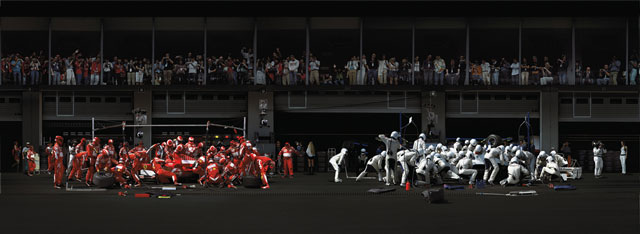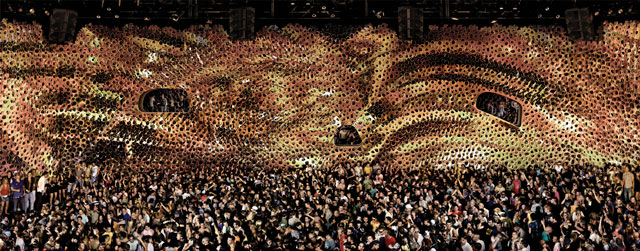[Spring 2010]
by John K. Grande
Andréas Gursky’s incredible take on the contemporary has much to do with the ascent of photography in the contemporary art world. And yet Gursky, as much as any photographier, is to be credited for raising that profile, thanks to his monumental photographic images. It is therefore ironic that for this travelling show co-organized by the Vancouver Art Gallery,1 the Kunstmuseen in Krefel, Germany, and the Moderna Museet in Stockholm, Sweden, Gursky has allowed the curator, Martin Hentschel, to show small-scale images of his photo-graphs for the first time in many years. While small photographs allow for a greater number of images to be exhibited, these works lessen the impact of the “known” Gursky images. They look almost ordinary in the standard size and scale, whereas the larger works (which are Gursky’s most recent ones) are stunning, at the level of history painting as Jean-Louis David might have defined it.
F1 Pit Stop IV (2007) is as close as contemporary art can get to Delacroix or Gericault. Ifs a modern-day epic, a large-scale Raft of the Medusa, so constructed and set up are the players in layers of detail. We see two pit-stop teams from a car-racing circuit. Each person is helmeted and wears a high-tech costume. They are action figures, real but Photoshopped, set together like pieces in a jigsaw puzzle – a montage such as William Notman would have done in the nineteenth century with his crowd scenes. There is always an overview, a larger context implicit to Gursky’s photography. In F1 Pit Stop IV, the onlookers above present a second level to this spectacle, and become a part of it, even as an audience.
Gursky’s imperative is as much sociological as it is categorical, whether he is photographing the Frankfurt Stock Exchange with its signboards and players, or Monaco, or the Tour de France. All of the events that Gursky records exist within a context that is rational, even empirical, for all its random scale, but the people seem small and insignificant. In one of the larger-sized photographs, Engadin II (2006), cross-country skiers seen from a great distance are reduced to dots in an expanse of snow – phenomenological dots perhaps, but dots nonetheless, part of Gursky’s world-scale photo scenario. Collectively, the skiers make a shaded line on the white winter land-scape. Pop star Madonna is micro too. We see Madonna at a 2001 concert, standing onstage in a colourful cloud of fans. They could be insects if we were aliens. The same goes for the crowd at a Tote Hosen concert shot taken in 2000. All of the light and colour is orchestrated so that the spectators become part of a near-abstract tableau. Occasional props and structures are inset into all the end-less flow of people. From the white siding of an industrial-scale shopping centre/construct, the words TOYOTA and TOYS “R” US intersect under overhead cabling and wiring.
In another photograph, a group of people is seated, tourist-like, in folding chairs under an awesome, momentous mountain. Elsewhere, nature threatens to engulf us all, just as the Maid of the Mist is engulfed by the voluminous spray of water from Niagara Falls. In the sky, two birds fly above this scene – a parallel visual world. People are everywhere: at a St. Moritz restaurant, in Genoa waiting for the ferryboat, in Sha Tin, on a Sunday walk at the Ratingen. It all starts to feel like a Kim Adams installation piece.
Ingenious humans, devilish humans. Humanity designs its own world, Gursky intuits. He moves from microcosm to macrocosm effortlessly.
In a smaller-scaled photograph, 99 Cent (1999), the presentation and packaging of multiple products in a supermarket, arranged rationally, expand horizontally and into the depth of field as if the photographer were giving us a glimpse of economies of scale not from the consumer’s point of view, but from that of the machines that made them, for the architecture expands the same principles. The container and the contained are similarly defined, and this is the genius of Gursky’s anomalous vision. In the digital photomontage Chicago Board of Trade II (1999), as in a picture of the Kuwait stock exchange, we are lost in a mirage of engagement amid the insect-like traders and players. The overview is Gursky’s and we share it, as if we were endlessly travelling through these scenes, neither committed to them nor fixated on their importance. Details in earlier works (also presented in small scale) such as Dusseldorf, Airplane (1989), in which an airplane overflies an innocuous, sparsely treed, uneventful landscape, and Ruhr Valley (1989), with its solitary figure walking under the structure of a highway bridge, reveal the evolution of Gursky’s photos. Even in these earlier photographs, the structures, products, and human interaction with the world are the essence of his vision, but the surfaces of his photos are as elusive as cellophane.
A display of running shoes is objectified in the expansive image Untitled V (1997), as is the interior design of a Prada store in Prada II (1997), another one of Gursky’s “big photos.” Three J. M. W. Turner paintings are mere objects in a museum installation in a smaller 1995 photograph. A large Jackson Pollock in Untitled VI (1997), for all its expressive intensity, is likewise contained by the civility of its architectural setting. Two somewhat smaller works (Untitled X and Untitled XI) from 1999 do the reverse, zooming into details of renowned artists’ paintings. Amid a forest of brushstrokes, the composition and context disappear, and the painting becomes a sociological or phenomenological study.
Gursky is as much sociologist as chronicler of a global economy in hyper-drive. An abstract photograph of a speedway in Bahrain, surrounded by sand, is so otherworldly that it looks almost like a naïve painting. The parasols aligned along a beach at Rimini form a seemingly endless rational and predictable procession. An Amsterdam arena, photographed in 2003, also reveals a world in which humans dominate, describe, and transform landscapes for recreation and production. The corporate leaders at an annual general meeting are presented sitting at a table inset into huge photographs of mountain landscapes and above all of this corporate logos hang in a vertiginous and pure image of sky -Siemens, VW, Bayer, Lufthansa Metro AG … Another reality is the development in Hong Kong in which a well of space filled with cranes, trucks, and building materials is surrounded by skyscraper apartment buildings – Dante-esque! Ingenious humans, devilish humans. Humanity designs its own world, Gursky intuits. He moves from microcosm to macrocosm effortlessly: Supernova (1999) captures something of the universe that we cannot see with the naked eye. And this mystery is part of Gursky’s mind/construct/photography. He seems to say it all with a totalitarian innocence and a capitalist sophistication. Whether it is the human species or the universe we live in, he is almost empirical in his quintessentially human methodology. The encyclopaedia of life that he is working on is one of images.
1 Andreas Gursky: Werke/Works 80-08 was presented by the Vancouver Art Gallery from May 30 to September 20, 2009.
John K. Grande is Curator Emeritus of Earth Art at the Royal Botanical Gardens in Burlington, Ontario. He is the author of Balance: Art and Nature (Black Rose Books, 1994), Art Nature Dialogues: Interviews with Environmental Artists (State University of New York Press, 2007), and Dialogues in Diversity: Art from Marginal to Mainstream (Pari Publishing, Italy, 2008). His latest books are The Landscape Changes (Propect/Gaspereau Press, 2009) and Art Allsorts: Writing on Art & Artists, 2 vols. (Go If Press, 2008,2009).



